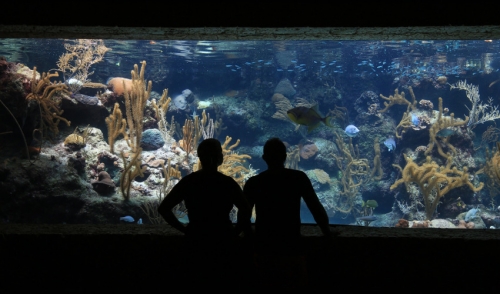
Aquariums are popular and widespread aquatic art, beautiful pets and an engaging hobby, but what do you really know about aquarium history? These great displays have been around far longer than most people realize, and used to look far different than today's designs.
Ancient Aquariums
The first recorded instance of aquariums was in the Roman Empire (approximately 37 B.C. to 400 A.D.). Ancient Romans used to keep freshwater barbels – carp relatives – in marble boxes in guest bedrooms, likely to represent the fresh fish their guests could enjoy at elaborate feasts. In China's early Ming Dynasty (1368-1644), goldfish were kept in porcelain bowls as elegant decorations. In other civilizations, there may be similar instances of fish kept as decorative objects, and many cultures have early instances of aquaculture similar to aquarium keeping, proving that fish have been close companions of humans for millennia.
Nineteenth Century Aquariums
It wasn't until the 1800s that aquarium keeping became more popular, particularly in Europe. Naturalism was of tremendous interest during the nineteenth century, and many researchers as well as interested hobbyists experimented with keeping live fish, corals, snails and similar aquatic creatures in primitive aquariums.
Because complicated pumps, filters, lights and heaters had not yet been invented, balanced aquariums were the most successful style in use in the 1800s. These were often wooden boxes sealed with pitch or similar materials, with a glass front for easy viewing. The bottom was typically made of slate, and could be gently heated through the stone if necessary. A balanced ecosystem of plants and animals in the water kept the aquarium active, and sunlight was essential to keep the aquarium healthy.
In 1853, the first public aquarium opened at the London Zoo, and the popularity of aquariums continued to grow throughout the 1850s, particularly in the United Kingdom, Germany and United States.
Twentieth Century Aquariums
The first major technological advances began to impact aquariums in the early twentieth century. The first water pump was designed in the early 1900s, and as electricity became more widely available after World War I (1914-1918), easy aquariums were even marketed as living toys for children. In the 1950s, developments in plastic shipping bags and efficient air transport allowed more exotic fish species to be kept in aquariums – until those innovations made shipping fish possible, only native fish were possible in aquariums.
From the 1960s to the 1980s, additional developments came with increasing speed – filters, lights, skimmers and other gear that made it possible to keep ever more complex aquatic systems thriving and healthy in a wide range of circumstances.
Aquariums Today
Today, there are always more developments in aquarium care, and it is possible for even novice hobbyists to enjoy a beautiful aquarium. In recent years, it is has become less accepted to use captured fish in an aquarium – many nations have outlawed importing wildly harvested fish – and captive-breeding programs have become far more widespread, giving aquarium lovers many wonderful options for their tanks. In addition to fish, coral reef aquariums are also growing in popularity, focusing on corals rather than fish in the aquarium.
In the United States alone, more than 10 million homes have at least one aquarium or fish tank, and while freshwater setups are far more popular because of their relative ease to establish and care for, more and more people are discovering the joy and beauty that any type of aquarium can bring to their home.







Comments